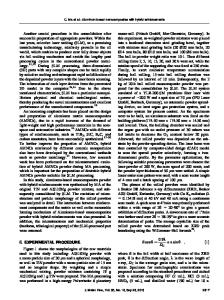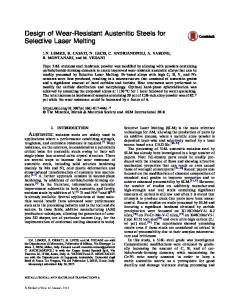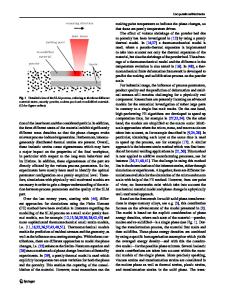Selective laser melting of aluminum alloys
- PDF / 1,223,456 Bytes
- 9 Pages / 580.752 x 783 pts Page_size
- 61 Downloads / 311 Views
troduction Many industrial sectors are now benefitting from the possibility of fabricating intricate structures using additive manufacturing (AM) technologies to achieve the objectives of lightweighting, increased functionality, and part number reduction. They also have the potential to fulfill demands for reducing the cost and design-to-manufacture time through savings on raw materials and replacement of a series of production processes by a single-step process,1–3 hence reducing lead times in multiprocess fabrication.4–8 Selective laser melting (SLM) is part of the family of powder bed AM techniques. SLM involves a series of steps, principally powder deposition and laser scanning,9 conducted within an inert controlled-atmosphere chamber to avoid oxidation.10 The parts are normally built on a temperaturecontrolled build plate (substrate) that acts as a heatsink and aids in heat dissipation by lowering the thermal gradient,11 avoiding part curling due to nonuniform thermal expansion.12 Modern AM dates back to the mid-1980s; its use expanded during the late 1980s and early 1990s, mainly as a method for manufacturing prototypes quickly.13,14 Only recently has AM been considered part of a new industrial revolution.15 A description of the evolution of AM can be found in Reference 16.
SLM is gaining wide popularity across industrial and scientific research sectors14,17 for applications in the aerospace, automotive, and biomedical fields.18 AM components are fabricated from loose powder, and have physical shapes and properties comparable to, and often even superior to, conventionally manufactured (CM) components.5,19 Part of the interest in SLM is driven by the increasing level of automation in the manufacturing sector along with production rates.20 As a powder bed process, SLM offers the geometrical flexibility to fabricate parts21 that in many cases cannot be manufactured using CM5,15 (some examples are shown in Figure 1). SLM promotes the possibility of producing highly customized products15 in low-to-medium quantities.19,22 Another benefit is eco-design optimization (optimizing the design to meet the functional requirements while using fewer resources during manufacturing and usage phases for a reduced impact on the environment), where significant structural lightweighting is possible, with a typically 50% weight reduction.23 SLM is also a promising technique to manufacture functionally graded multimaterial parts.6,24,25 In SLM, a thin layer of feedstock powder is deposited by a wiper or roller mechanism. A laser then scans across the powder bed line by line, melting the powder into cylindrical
Nesma T. Aboulkhair, Centre for Additive Manufacturing, The University of Nottingham, UK; [email protected] Nicola M. Everitt, Bioengineering Research Group, The University of Nottingham, UK; [email protected] Ian Maskery, Centre for Additive Manufacturing, The University of Nottingham, UK; [email protected] Ian Ashcroft, Centre for Additive Manufacturing, The University of Nottingham, UK; ian
Data Loading...











